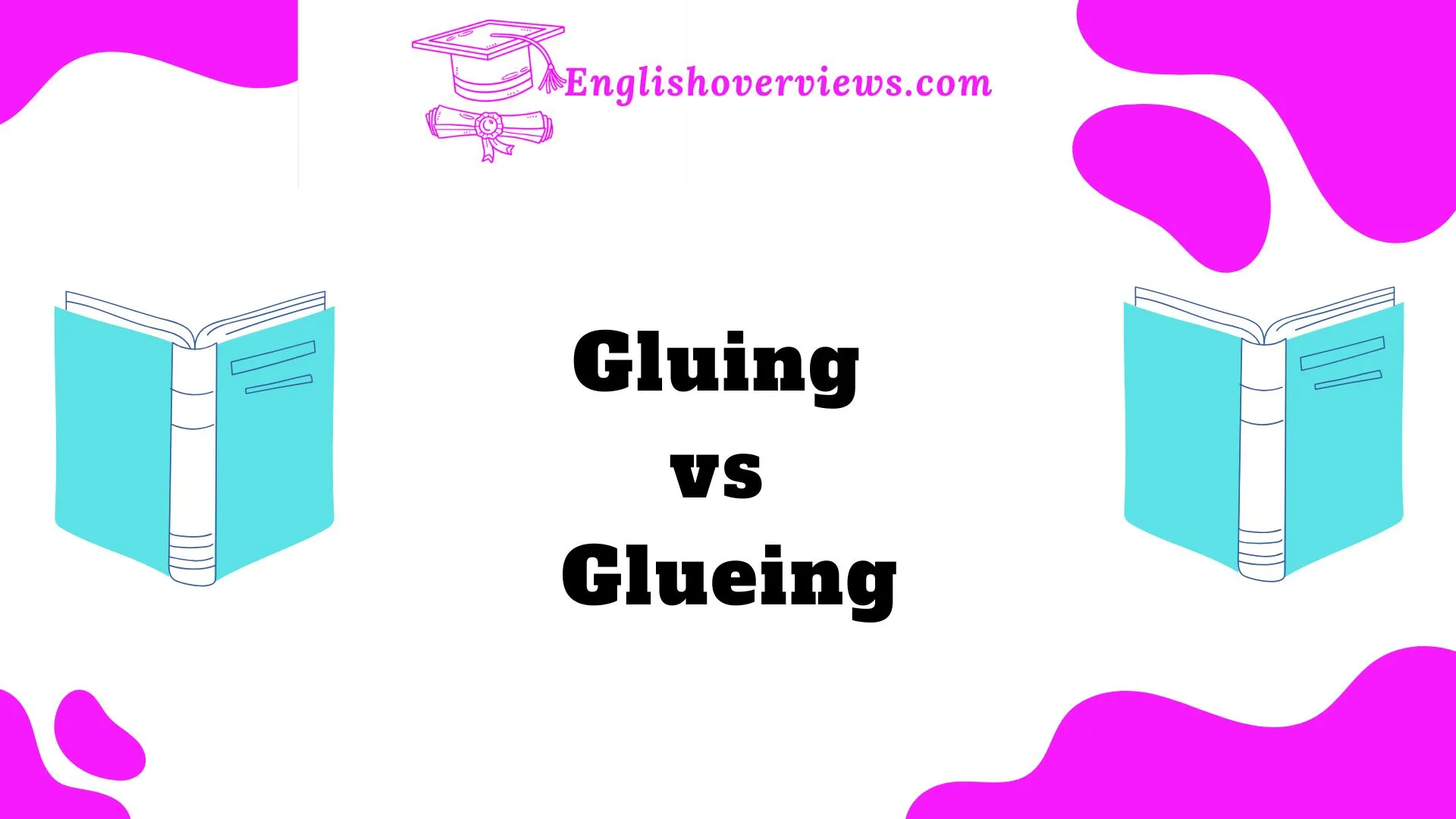When it comes to English spelling, a lot of us stumble over small details that can make a big difference. One such point of confusion is the debate over “gluing” vs. “glueing.”
While both words seem to make sense at first glance, the truth is that one of them is simply incorrect in most contexts. So, which one should you use? And why does it matter?
In this ultimate guide, we’ll dive deep into the difference between gluing and glueing, explore their historical roots, and explain how to ensure you use the correct spelling in your writing. We’ll also look at real-world examples, common mistakes, and tips for avoiding them.
Whether you’re crafting a letter, working on an academic paper, or just writing a quick email, understanding this distinction can improve the clarity and professionalism of your writing.
The Origin of the Gluing/Glueing Debate
The confusion between “gluing” and “glueing” isn’t just a modern-day issue. It has its roots deep in the history of the English language. Historically, English has allowed for some variation in spelling, especially when it comes to words derived from verbs ending in -e. The addition of -ing to verbs like “glue” or “glue” has led to different forms being used interchangeably, at least in earlier times.
However, over time, language standards evolved, and most English guides and dictionaries now accept only “gluing” as the correct form.
Key Historical Points:
- Early Use of “Glueing”: The variant “glueing” was once more common, especially in older texts, before standard spelling conventions were firmly established.
- Rise of “Gluing”: As dictionaries like Merriam-Webster and Oxford set spelling rules, “gluing” became the accepted form in both American and British English, largely due to phonetic consistency and grammar rules.
Why the Change?
The shift to “gluing” was driven by standardization of spelling. English writers and grammarians sought to remove ambiguities, and simplifying forms like “gluing” over “glueing” helped make spelling easier to predict.
Gluing vs. Glueing: Is There a Real Difference?
At the heart of the gluing vs. glueing debate is a simple truth: only “gluing” is considered correct. Here’s a closer look at the differences:
1. “Gluing” – The Correct Form
- Standard Spelling: “Gluing” is the preferred form in both American and British English.
- Common Usage: Whether you’re referring to a craft project, industrial applications, or just a casual reference to using glue, “gluing” is always the right choice.
- Examples:
- “I am gluing the pieces of paper together.”
- “She’s gluing the frame to the wall.”
2. “Glueing” – The Misspelled Form
- Outdated and Incorrect: While “glueing” was once acceptable, it’s now considered a spelling mistake in most contexts.
- Rare Usage: Some old texts or informal writing might still use “glueing,” but modern guides and editors reject it.
- Examples:
- Incorrect: “I am glueing the box shut.”
- Correct: “I am gluing the box shut.”
American vs. British English: A Spelling Divide
The gluing vs. glueing question is mostly settled in American English, where “gluing” reigns supreme. However, British English can sometimes be more flexible, with “glueing” appearing in older texts or informal writing.
Here’s a breakdown of how both variations are used:
| Region | Preferred Form | Alternative (Rare) |
| American English | Gluing | – |
| British English | Gluing | Glueing (Old texts) |
Why the Divide?
British English sometimes retains older forms longer than American English due to different linguistic influences. American English has been quicker to adopt standardized spelling rules, resulting in a more consistent approach to words like “gluing.”
Understanding the Verb “Gluing”
Let’s break down what “gluing” actually means. At its core, “gluing” is the act of using glue to stick things together. It’s a verb that describes a process in which two or more objects are bonded using an adhesive substance.
- Examples:
- “She’s gluing the tiles to the wall.”
- “I’m gluing the envelope shut.”
Common Uses of “Gluing”:
- Crafting: When making greeting cards or scrapbooking.
- Construction: In bonding materials like wood or tiles.
- Medical: In modern surgeries, doctors may use glue to seal wounds (a common practice in non-invasive procedures).
Why “Glueing” is a Spelling Mistake You Want to Avoid
If you still find yourself using “glueing,” it’s time to make the switch. “Glueing” can make you appear less professional, as it’s considered incorrect by most grammar and writing authorities.
- Impact on Professional Writing: Using “glueing” instead of “gluing” can confuse your audience and reduce your credibility.
- In Academic and Professional Contexts: Avoiding common spelling mistakes is crucial. Spelling errors like “glueing” can hurt the clarity and impact of your message, particularly in formal settings.
The Misconception of “Glueing” in Modern Writing
One of the most common misconceptions is that “glueing” might be an acceptable alternative. Some might argue that it’s a regional variation or even an “alternative” spelling. However, this view is outdated and inaccurate.
- Grammar Guides: Major guides, including the Chicago Manual of Style and Oxford English Dictionary, categorically reject “glueing.”
- Common Mistakes: Writers sometimes use “glueing” because it feels phonetically correct. But spelling should be based on rules rather than sounds alone.
The Correct Spelling: Why “Gluing” is King
To enhance your writing and ensure clarity, always stick to “gluing”. Here’s why:
- It’s Standardized: Both American and British English have adopted “gluing” as the proper spelling.
- It’s Phonetically Consistent: The word “gluing” follows typical English spelling rules, where verbs ending in -e add an -ing suffix without doubling the vowel.
- It’s Widely Accepted: “Gluing” is the form used in nearly every reputable dictionary and style guide.
How to Avoid Common Spelling Mistakes
Now that you know the difference between “gluing” and “glueing,” here are some quick tips to avoid spelling mistakes:
- Practice: When in doubt, always use “gluing.” Say it out loud if you’re unsure.
- Use Spell-Check Tools: Many grammar-checking tools (like Grammarly) can help you spot and correct errors like “glueing.”
- Read Aloud: Before submitting any important document, read it aloud to catch any unnoticed errors.
Mnemonic Tip:
Think of the rule as: “When in doubt, glue it, don’t gluee it.”
Real-World Examples
Here are a few case studies to show you how spelling can affect communication:
- Case Study 1: A student submitting an essay on a science project used “glueing” throughout their paper. While their ideas were solid, the frequent spelling mistake reduced the professionalism of their work. After correcting to “gluing,” their essay looked more polished.
- Case Study 2: In a corporate report, one employee accidentally wrote “glueing” in a technical section. The report was sent to a client who is highly detail-oriented. Fortunately, they missed the error, but it could have hurt the company’s reputation if noticed.
Conclusion: Mastering Your Writing
By now, you should be clear on the correct spelling—it’s “gluing” and always will be. Using the right spelling ensures that your writing is professional, clear, and credible. Avoid the common mistake of using “glueing” and elevate your writing today!
FAQs
Q1: Is “glueing” ever acceptable?
A1: No, “glueing” is considered a spelling mistake in modern English and should be avoided.
Q2: Why is “gluing” the preferred spelling?
A2: “Gluing” follows English grammar rules and is the standard form accepted by all major dictionaries.
Q3: What’s the best way to remember the difference?
A3: Use a simple mnemonic: “When in doubt, glue it, don’t gluee it.”
Q4: Are there any exceptions to the rule? A4: No exceptions. “Gluing” is always the correct form.
Q5: Can regional variations affect the use of “gluing”?
A5: While some older British texts used “glueing,” modern writing standards universally accept “gluing” as the correct spelling.

Alyan Ashraf is the creative mind behind English Overviews, a platform dedicated to helping learners master the English language. Passionate about education and language development, Alyan specializes in simplifying complex English concepts, making learning accessible for students of all levels.











